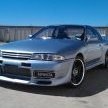Dyno Sheets
Announcements
-
Similar Content
-
Latest Posts
-
By hoodedreeper · Posted
Next on the to-do list was an oil and filter change. Nothing exciting to add here except the oil filter is in a really stupid place (facing the engine mount/subframe/steering rack). GReddy do a relocation kit which puts it towards the gearbox, I would have preferred towards the front but there's obviously a lot more stuff there. Something I'll have to look at for the next service perhaps. First time using Valvoline oil, although I can't see it being any different to most other brands Nice... The oil filter location... At least the subframe wont rust any time soon I picked up a genuine fuel filter, this is part of the fuel pump assembly inside the fuel tank. Access can be found underneath the rear seat, you'll see this triangular cover Remove the 3x plastic 10mm nuts and lift the cover up, pushing the rubber grommet through The yellow fuel line clips push out in opposite directions, remove these completely. The two moulded fuel lines can now pull upwards to disconnect, along with the wire electrical plug. There's 8x 8mm bolts that secure the black retaining ring. The fuel pump assembly is now ready to lift out. Be mindful of the fuel hose on the side, the hose clamp on mine was catching the hose preventing it from lifting up The fuel pump/filter has an upper and lower section held on by 4 pressure clips. These did take a little bit of force, it sounded like the plastic tabs were going to break but they didn't (don't worry!) The lower section helps mount the fuel pump, there's a circular rubber gasket/grommet/seal thing on the bottom where the sock is. Undo the hose clip on the short fuel hose on the side to disconnect it from the 3 way distribution pipe to be able to lift the upper half away. Don't forget to unplug the fuel pump too! There's a few rubber O rings that will need transferring to the new filter housing, I show these in the video at the bottom of this write up. Reassembly is the reverse Here's a photo of the new filter installed, you'll be able to see where the tabs are more clearing against the yellow OEM plastic Once the assembly is re-installed, I turned the engine over a few times to help build up fuel pressure. I did panic when the car stopped turning over but I could hear the fuel pump making a noise. It eventually started and has been fine since. Found my 'lucky' coin underneath the rear seat too The Youtube video can be seen here: https://www.youtube.com/watch?v=uLJ65pmQt44&t=6s -
By hoodedreeper · Posted
It was picked up on the MOT/Inspection that the offside front wheel bearing had excessive play along with the ball joint. It made sense to do both sides so I sourced a pair of spare IS200 hubs to do the swap. Unfortunately I don't have any photos of the strip down but here's a quick run down. On the back of the hub is a large circular dust cover, using a flat head screw driver and a mallet I prised it off. Underneath will reveal a 32mm hub nut (impact gun recommended). With the hub nut removed the ABS ring can be removed (I ended up using a magnetic pick up tool to help). Next up is to remove the stub axle, this was a little trickier due to limited tools. I tried a 3 leg puller but the gap between the hub and stub axle wasn't enough for the legs to get in and under. Next option was a lump hammer and someone pulling the stub axle at the same time. After a few heavy hits it released. The lower bearing race had seized itself onto the stub axle, which was fine because I was replacing them anyway. With the upper bearing race removed and the grease cleaned off they looked like this The left one looked pristine inside but gave us the most trouble. The right one had some surface rust but came apart in a single hit, figure that out?! I got a local garage to press the new wheel bearings in, reassemble was the opposite and didn't take long at all. Removing the hub itself was simple. Starting with removing the brake caliper, 2x 14mm bolts for the caliper slider and 2x 19mm? for the carrier > hub bolts. I used a cable tie to secure the caliper to the upper arm so it was out of the way, there's a 10mm bolt securing the ABS sensor on. With the brake disc removed from the hub next are the three castle nuts for the upper and lower ball joints and track rod end. Two of these had their own R clip and one split pin. A few hits with the hammer and they're released (I left the castle nuts on by a couple of turns), the track rod ends gave me the most grief and I may have nipped the boots (oops). Fitting is the reversal and is very quick and easy to do. The lower ball joints are held onto the hub by 2x 17mm bolts. The castle nut did increase in socket size to 22mm from memory (this may vary from supplier) The two front tyres weren't in great condition, so I had those replaced with some budget tyres for the time being. I'll be replacing the wheels and tyres in the future, this was to get me on the road without the worry of the police hassling me. -
Yep, the closest base tune available was for the GTT, I went with that and made all the logical changes I could find to convert it to Naturally Aspirated. It will rev fine in Neutral to redline but it will be cutting nearly 50% fuel the whole way. If I let it tune the fuel map to start with that much less fuel it wont run right and has a hard time applying corrections. These 50% cuts are with a fuel map already about half of what the GTT tune had. I was having a whole lot of bogging when applying any throttle but seem to have fixed that for no load situations with very aggressive transient throttle settings. I made the corrections to my injectors with data I found for them online, FBCJC100 flowing 306cc. I'll have to look to see if I can find the Cam section. I have the Bosch 4.9 from Haltech. My manifold pressure when watching it live is always in -5.9 psi/inHg
-
Hi My Tokico BM50 Brake master cylinder has a leak from the hole between the two outlets (M10x1) for brake pipes, I have attached a photo. Can anyone tell me what that hole is and what has failed to allow brake fluid to escape from it, I have looked on line and asked questions on UK forums but can not find the answer, if anyone can enlighten me I would be most grateful.
-





Recommended Posts
Create an account or sign in to comment
You need to be a member in order to leave a comment
Create an account
Sign up for a new account in our community. It's easy!
Register a new accountSign in
Already have an account? Sign in here.
Sign In Now